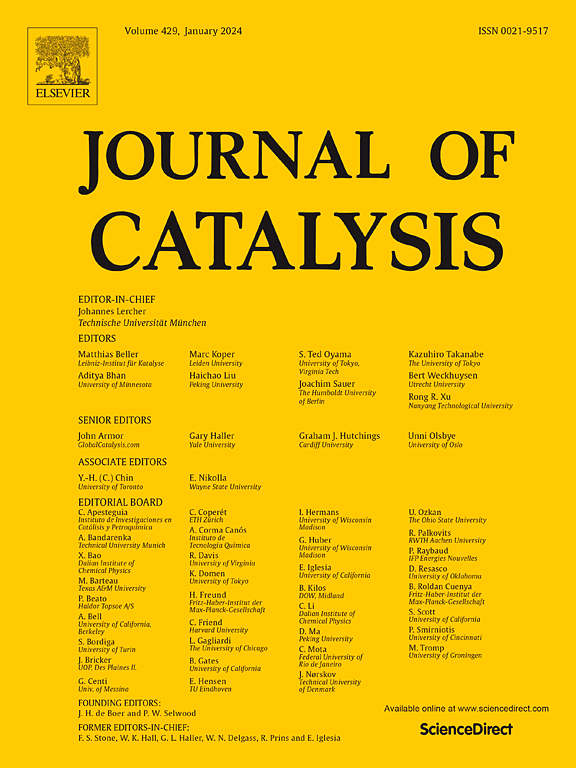Hierarchical hollow silicalite encapsulated Cu-Fe oxides for selectively oxidative depolymerization of lignin to diethyl meleate
IF 6.5
1区 化学
Q2 CHEMISTRY, PHYSICAL
引用次数: 0
Abstract
Heterogeneously catalytic depolymerization of lignin into value-added biochemicals are imperative, yet challengeable by the limited mass transport of lignin and the non-ideal spatial distributions of active sites in catalysts. Herein, a series of polycrystalline materials with Cu and Fe oxides encapsulated in hierarchical hollow nano silicalite (Cux-Fey@HhNS) were designed for step-by-step oxidative conversion of lignin into diethyl meleate (DEM). 92.0 % conversion of lignin with an exceptional DEM yield of 31.2 wt% and selectivity of 70.7 % was achieved at 150 °C for 24 h using Cu2.5-Fe2.2@HhNS. A series of controlled experiments and characterization showed clearly that the superior performance in DEM production was attributed to the enhanced tandem processes of lignin Cα-Cβ bonds deconstruction by framework Cu2+, subsequently aromatic ring-cleavage by the isolated framework Fe3+, and the well-balanced micro-/mesoporosity ratio of Cux-Fey@HhNS facilitates the diffusion of lignin macromolecules/products, contributing to the excellent DEM yield and selectivity as well. Further mechanistic investigation illustrated that the process proceeds via a single electron transfer pathway. Consequently, this work provides new insights into lignin valorization to bulk chemicals, paving the way for biomass-derived recyclable polymeric materials as sustainable alternative to traditional petroleum-based routes.


分层中空硅石包封Cu-Fe氧化物,用于木质素选择性氧化解聚制meleate二乙酯
木质素的多相催化解聚是必要的,但木质素的有限质量运输和催化剂活性位点的非理想空间分布是具有挑战性的。本文设计了一系列将Cu和Fe氧化物包裹在层次化中空纳米硅石(Cux-Fey@HhNS)中的多晶材料,用于木质素逐步氧化转化为meleate二乙酯(DEM)。使用Cu2.5-Fe2.2@HhNS,在150 °C、24 h条件下,木质素转化率达到92.0 %,DEM产率达到31.2 wt%,选择性达到70.7 %。一系列对照实验和表征清楚地表明,在DEM生产中的优异性能归因于木质素c - α- c - β键被框架Cu2+分解,随后被分离的框架Fe3+裂解芳环的串联过程,以及Cux-Fey@HhNS平衡的微介孔比有利于木质素大分子/产物的扩散,也有助于良好的DEM产率和选择性。进一步的机理研究表明,这一过程是通过单一的电子转移途径进行的。因此,这项工作为木质素增值到散装化学品提供了新的见解,为生物质衍生的可回收聚合物材料作为传统石油基路线的可持续替代品铺平了道路。
本文章由计算机程序翻译,如有差异,请以英文原文为准。
求助全文
约1分钟内获得全文
求助全文
来源期刊

Journal of Catalysis
工程技术-工程:化工
CiteScore
12.30
自引率
5.50%
发文量
447
审稿时长
31 days
期刊介绍:
The Journal of Catalysis publishes scholarly articles on both heterogeneous and homogeneous catalysis, covering a wide range of chemical transformations. These include various types of catalysis, such as those mediated by photons, plasmons, and electrons. The focus of the studies is to understand the relationship between catalytic function and the underlying chemical properties of surfaces and metal complexes.
The articles in the journal offer innovative concepts and explore the synthesis and kinetics of inorganic solids and homogeneous complexes. Furthermore, they discuss spectroscopic techniques for characterizing catalysts, investigate the interaction of probes and reacting species with catalysts, and employ theoretical methods.
The research presented in the journal should have direct relevance to the field of catalytic processes, addressing either fundamental aspects or applications of catalysis.
 求助内容:
求助内容: 应助结果提醒方式:
应助结果提醒方式:


